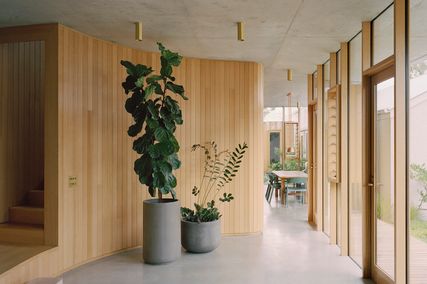Imagine a future where Sydney, Hobart and Darwin experience severe flooding almost every day. Food and drinking water are contaminated, leading to 870,000 cases of bacterial gastroenteritis. Infectious diseases are rife, with between five and eight million people exposed to dengue fever. Heat stress, power outages, breakdowns in public transport, and psychological and behavioural disorders are all wreaking havoc.
According to the Climate Council’s report Climate change 2015: Growing risks, critical choices, this is the scenario Australia will face in 2100 if nothing is done to curb today’s greenhouse gas emissions. In 2018, the United Nations warned the world that we have only 12 years left to limit global warming to 1.5°C and that it would require “rapid, far-reaching and unprecedented changes in all aspects of society.”
Although time is running out, it’s not too late to change the trajectory, and architects are well-placed to lead the change. After all, according to the World Green Building Council (WGBC), buildings are currently responsible for 39 percent of global energy-related carbon emissions. The WGBC threw down the gauntlet with its Bringing embodied carbon upfront report (2019), which called for the sector “to dramatically change the way buildings are designed, built, used and deconstructed.”
We spoke to some leading voices in the Australian architecture profession – all of them signatories to a worldwide declaration of climate and biodiversity emergency – about what action needs to be taken moving forward.
Jeremy McLeod, founder and director of Breathe Architecture, says the Victorian leaders of Architects Declare Australia have been working on a three-step plan to help the broader architecture community achieve carbon neutrality.
“Everyone who studied architecture in the last 20 years already knows what they have to do. Our job is to help them come to the realization that they just need to do it and be tenacious enough to bring their clients along with them,” he said.
One of the biggest factors is managing client expectations and influencing them to make more sustainable choices.
“Architects will have a really big role in helping their clients and perhaps reshape their projects into the sustainable projects they need to be,” said Architects Declare Australia spokesperson Caroline Pidcock.
“Clients look to their architects for leadership in providing valuable buildings or valueable outcomes for them. The most valuable outcome we can provide at the moment is a building that is really low carbon in its building and operation and really resilient for different weather conditions going forward. The biggest role that architects need to have to bring clients along on that journey and I think they do need to be able to walk away from a project when the client won’t or don’t want to come on that journey.”
Helen Lochhead, 2019–20 national president of the Australian Institute of Architects, said, “It’s our responsibility to educate clients, it’s our responsibility to advocate for better policy, it’s our responsibility to ensure that we design to, and support, better standards through our advocacy as an institute and make submissions to government to speak with ministers about what government should be doing.”
McLeod, Pidcock and Lochhead are all part of our interview series on the actions architects need to take to achieve a sustainable future. We asked 10 industry leaders about the preparedness of the industry, the challenges architects are facing, how architects can encourage their clients to be more sustainable, and how to limit the use of materials with high levels of embodied carbon. Their responses highlight the complex, diverse and myriad approaches architects can take.
Caroline Pidcock: Build less, build smaller
Jeremy McLeod: Simple steps toward a sustainable future
Paul Toyne: Achieving net zero is just a start
Jefa Greenaway: Lessons from Indigenous knowledge systems
Helen Lochhead: Educating clients is the responsibility of every architect
Ken Maher: Minimum standards must be lifted significantly
Kerry and Lindsay Clare: Super highrise is not the answer
Emma Williamson: If we want to make the biggest impact, we can’t just be obsessed with the building
Neil Logan: An action plan of knowledge, advocacy and design
Belinda Allwood and Ellen Buttrose: Climate nad politics in the tropics
Read more articles from the climate and biodiversity emergency series.
















